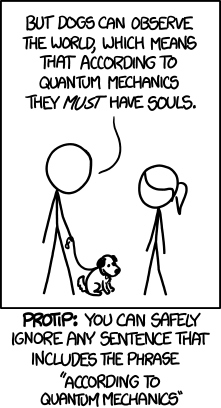I can only imagine that advertising is the main reason for the flamboyant use of the word quantum, since it is essentially a fancy word for "smallest amount of some physical entity." For something to be quantised means that it is made up of small indivisible quantities - for instance, spin of particles is quantised such that, for instance, electrons can only have some integer multiple of a half spin. So either these quantum products are "quantum" for their sexiness, or they are somehow quantised in such a way that is don't-ask-me-how relevant to the consumer. I suspect the former.
The other side of quantum mechanics (QM) in popular culture is not on the market but in the way people use QM to intellectualise their odd views about the world. For instance, there is esoteric views of "Quantum Healing" espoused by Deepak Chopra or wacky New Age perversions of the theory. Of course, to a physicist, all of that misuse of science amounts to a grand "quantum flapdoodle" (to use Murray Gell-Mann's term). In general, it is wisest to follow the advice of xkcd on this point when speaking to someone who has no background in actual physics:
But what if you do not want to be in the riff raff ignorant of quantum mechanics and rise to the lofty heights of someone who can honestly claim to not understand it? The fact of the matter is, quantum mechanics is weird because it operates on a different logic to what we are used to in "classical" physics. By all means, baffle your brains out by trying to picture interference patterns from double slit experiments with buckyballs (sixty carbon atoms arranged like a football) in terms of it acting like a wave and a particle. When you are suitably confused by that, perhaps you will appreciate that understanding the logic of QM gives far more insight, I think, into why QM seems so outlandish to us.
For those that are averse to mathematics, a career in quantum mechanics is not for you. Like most theories in physics, quantum mechanics has two parts:
- Equations.
- Interpretations which explain how the symbols in the equations relate to real world phenomena.
Still, the basic structure of the equations of quantum mechanics explains why we find it so un-intuitive: in QM, systems are described by states in Hilbert space. By contrast, classical systems are described by points in phase space. Even without really understanding what the Hilbert and phase spaces are, the underlying point is that the way we have to think about the inner workings of quantum compared to the more intuitive classical mechanics is fundamentally different. It would be, to use a crude analogy, like asking a car mechanic to work on a space shuttle: there are obviously certain similarities, but at the end of the day, car engines run off explosions which move pistons whereas rockets shoot fuel out their rear end to go forwards; they are incommensurate.
Let me finally state all the fundamental postulates of quantum mechanics:
- Physical systems are described by states in Hilbert space.
- Those systems evolve according to the Schrodinger equation (or equivalents, such as Heisenberg matrix mechanics and Feynman path integral formulation), given some Hamiltonian for the system (where the Hamiltonian is the functional of energy).
Some physics-literate people may protest that I am missing an extra postulate. You see, part of the charm of quantum mechanics is that Hilbert space is mysterious and hidden. This means that you cannot actually measure wavefunctions - and this is quite the problem, because if you cannot measure wavefunctions and you hold that wavefunctions are what describe physical systems, then it would seem that physical systems cannot be measured. That has to be false, though, because we clearly measure things all the time. So they add in another postulate which explains measurements:
- The probability of measuring a system to be in some possible state is given by the Born rule, which "collapses" the wavefunction - in other words, measuring a system makes the wavefunction look like a very sharp spike at the value you measured.
You can write that all in terms of the mathematical formalism, which is of course a necessary step, but if you leave this blogpost understanding nothing more than that fundamental difference between quantum and classical mechanics (ie, Hilbert vs. phase spaces), you will understand more than practically anyone outside of science. But why leave maths out of it when you can put it in for good measure? Here are the postulates in their mathematical glory:
Physical systems are described by states in Hilbert space which are written in Dirac notation with "bra"s (1) and "ket"s (2) (which together make bra-kets, or brackets):
$$\begin{equation}\label{eq:bra}\langle\phi\rvert \end{equation}$$ $$\begin{equation}\label{eq:ket}\lvert\psi\rangle \end{equation}$$
The bras are just the Hermitian conjugates of the kets - they correspond to the same vectors in the opposite sides of dual space.
Observables are the things you measure, and in quantum mechanics, they are described by Hermitian ("self-adjoint") operators such that: $$ \hat A = \hat A^\dagger$$
The possible results of measuring some observable are the eigenvalues of that operator. In other words, if you take the momentum operator: $$\mathbf {\hat p} = -i\hbar\mathbf{\nabla}$$
These systems evolve (change over time) according to the Schrodinger equation:
$$\displaystyle i\hbar\frac{\partial \psi}{\partial t} = \frac{-\hbar^2}{2m} \nabla^2 \psi + V \psi$$
Or compactly and in terms of bras and kets:
$$i\hbar\frac{\partial\lvert\psi\rangle}{\partial t} = \hat H \lvert\psi\rangle$$
Finally, the Born rule can be written as (where x is just standing in for any observable, not necessarily an x coordinate):
$$P(x=a) = |\langle\phi(a)\rvert\psi(a)\rangle|^2$$
There you have it; that is all there is to fundamental quantum mechanics. Use your knowledge for good.

No comments:
Post a Comment